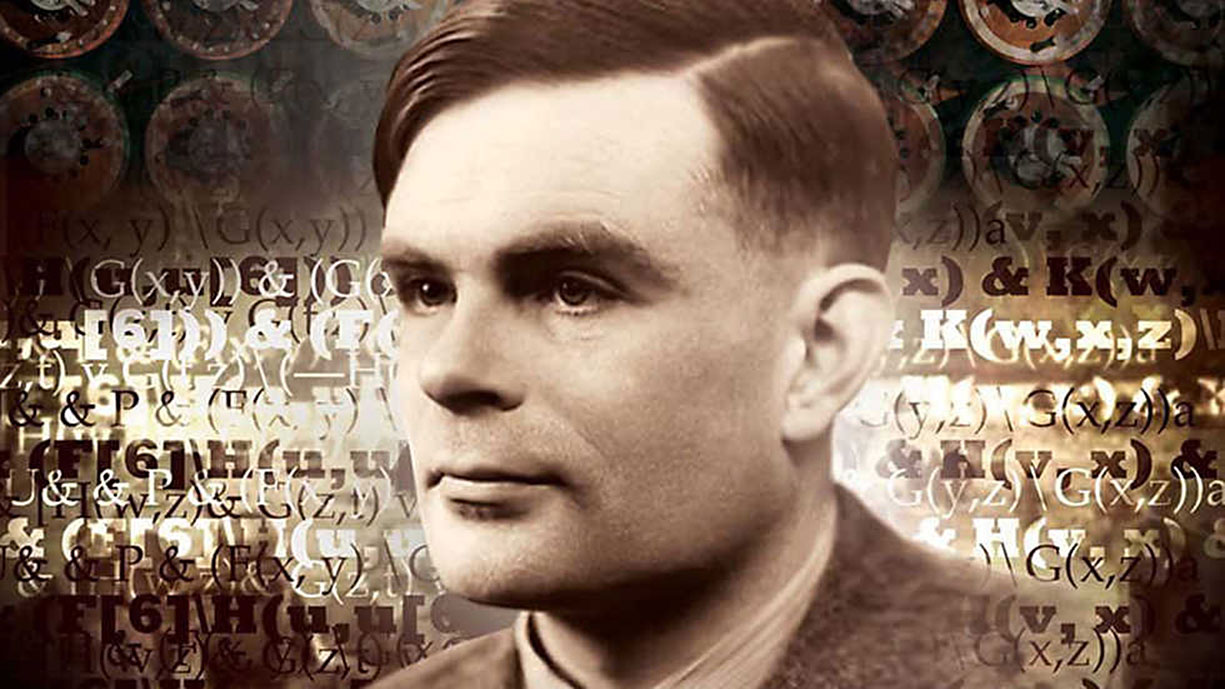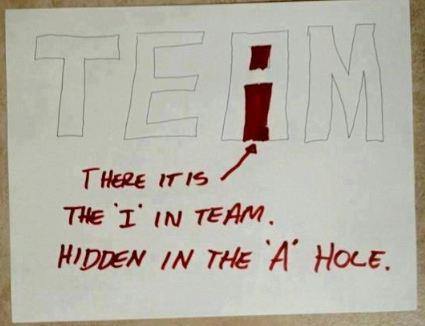|
|
|
Friday, March 22nd, 2019

This recent post from Wally Bock seemed like a great way to wrap up this week’s commentary about values and bosses.
Alan Turing made many contributions to the Allied effort in World War II and to the many fields that have coalesced into computer science. He’s best known among laypeople like me for his “Turing Test,” a test of whether a computer can exhibit intelligent behavior like a human being.
My question for you is: “Could you pass such a test?” If I watched you work for a few hours, would it be obvious that you were a human being and not some kind of AI-powered, cyborg-boss?
In my career I’ve seen too many bosses who couldn’t. They imagined their job as passing on instructions and enforcing regulations. One of their favorite phrases is “I have no choice …”
Most bosses aren’t that way. They may not get everything right, but it’s clear that they’re human beings struggling to do the right thing. That’s probably where you fit, but let’s check. Is it obvious that you’re a real human being or do you act like a walking, talking bunch of algorithms?
Do you take time to have frequent conversations with your team members where you do something more than just pass on directives?
Do you strive to be fair to everyone while you make adjustments for individual strengths, weaknesses, and preferences?
Do you argue for your team or team member when something comes down from above that’s wrong or unfair?
Do you help your team members grow, develop, and succeed?
Boss’s Bottom Line
Human bosses who act intelligently are the best for human beings. That means more than passing on instructions and enforcing rules and standards. Show your humanity by acknowledging the emotion in the workplace and by using both your brain and your heart
Image credit: HikingArtist
Posted in Communication, Culture, Entrepreneurs, If the Shoe Fits | No Comments »
Friday, February 23rd, 2018

A Friday series exploring Startups and the people who make them go. Read all If the Shoe Fits posts here.
If I have to listen/read one more time about value/importance/etc of hiring “stars” or the “best” whatever I think I may scream. Or, better yet, shove the words/premise down the appropriate throat.
While I, and a small minority, have tried to debunk this mindset we haven’t made much progress.
So here’s an article from Scott E Page, the Leonid Hurwicz collegiate professor of complex systems, political science and economics at the University of Michigan, Ann Arbor.
Perhaps you’ll pay attention to him.
Why hiring the ‘best’ people produces the least creative results
While in graduate school in mathematics at the University of Wisconsin-Madison, I took a logic course from David Griffeath. The class was fun. Griffeath brought a playfulness and openness to problems. Much to my delight, about a decade later, I ran into him at a conference on traffic models. During a presentation on computational models of traffic jams, his hand went up. I wondered what Griffeath – a mathematical logician – would have to say about traffic jams. He did not disappoint. Without even a hint of excitement in his voice, he said: ‘If you are modelling a traffic jam, you should just keep track of the non-cars.’
The collective response followed the familiar pattern when someone drops an unexpected, but once stated, obvious idea: a puzzled silence, giving way to a roomful of nodding heads and smiles. Nothing else needed to be said.
Griffeath had made a brilliant observation. During a traffic jam, most of the spaces on the road are filled with cars. Modelling each car takes up an enormous amount of memory. Keeping track of the empty spaces instead would use less memory – in fact almost none. Furthermore, the dynamics of the non-cars might be more amenable to analysis.
Versions of this story occur routinely at academic conferences, in research laboratories or policy meetings, within design groups, and in strategic brainstorming sessions. They share three characteristics. First, the problems are complex: they concern high-dimensional contexts that are difficult to explain, engineer, evolve or predict. Second, the breakthrough ideas do not arise by magic, nor are they constructed anew from whole cloth. They take an existing idea, insight, trick or rule, and apply it in a novel way, or they combine ideas – like Apple’s breakthrough repurposing of the touchscreen technology. In Griffeath’s case, he applied a concept from information theory: minimum description length. Fewer words are required to say ‘No-L’ than to list ‘ABCDEFGHIJKMNOPQRSTUVWXYZ’. I should add that these new ideas typically produce modest gains. But, collectively, they can have large effects. Progress occurs as much through sequences of small steps as through giant leaps.
Third, these ideas are birthed in group settings. One person presents her perspective on a problem, describes an approach to finding a solution or identifies a sticking point, and a second person makes a suggestion or knows a workaround. The late computer scientist John Holland commonly asked: ‘Have you thought about this as a Markov process, with a set of states and transition between those states?’ That query would force the presenter to define states. That simple act would often lead to an insight.
The burgeoning of teams – most academic research is now done in teams, as is most investing and even most songwriting (at least for the good songs) – tracks the growing complexity of our world. We used to build roads from A to B. Now we construct transportation infrastructure with environmental, social, economic and political impacts.
The complexity of modern problems often precludes any one person from fully understanding them. Factors contributing to rising obesity levels, for example, include transportation systems and infrastructure, media, convenience foods, changing social norms, human biology and psychological factors. Designing an aircraft carrier, to take another example, requires knowledge of nuclear engineering, naval architecture, metallurgy, hydrodynamics, information systems, military protocols, the exercise of modern warfare and, given the long building time, the ability to predict trends in weapon systems.
The multidimensional or layered character of complex problems also undermines the principle of meritocracy: the idea that the ‘best person’ should be hired. There is no best person. When putting together an oncological research team, a biotech company such as Gilead or Genentech would not construct a multiple-choice test and hire the top scorers, or hire people whose resumes score highest according to some performance criteria. Instead, they would seek diversity. They would build a team of people who bring diverse knowledge bases, tools and analytic skills. That team would more likely than not include mathematicians (though not logicians such as Griffeath). And the mathematicians would likely study dynamical systems and differential equations.
Believers in a meritocracy might grant that teams ought to be diverse but then argue that meritocratic principles should apply within each category. Thus the team should consist of the ‘best’ mathematicians, the ‘best’ oncologists, and the ‘best’ biostatisticians from within the pool.
That position suffers from a similar flaw. Even with a knowledge domain, no test or criteria applied to individuals will produce the best team. Each of these domains possesses such depth and breadth, that no test can exist. Consider the field of neuroscience. Upwards of 50,000 papers were published last year covering various techniques, domains of enquiry and levels of analysis, ranging from molecules and synapses up through networks of neurons. Given that complexity, any attempt to rank a collection of neuroscientists from best to worst, as if they were competitors in the 50-metre butterfly, must fail. What could be true is that given a specific task and the composition of a particular team, one scientist would be more likely to contribute than another. Optimal hiring depends on context. Optimal teams will be diverse.
Evidence for this claim can be seen in the way that papers and patents that combine diverse ideas tend to rank as high-impact. It can also be found in the structure of the so-called random decision forest, a state-of-the-art machine-learning algorithm. Random forests consist of ensembles of decision trees. If classifying pictures, each tree makes a vote: is that a picture of a fox or a dog? A weighted majority rules. Random forests can serve many ends. They can identify bank fraud and diseases, recommend ceiling fans and predict online dating behaviour.
When building a forest, you do not select the best trees as they tend to make similar classifications. You want diversity. Programmers achieve that diversity by training each tree on different data, a technique known as bagging. They also boost the forest ‘cognitively’ by training trees on the hardest cases – those that the current forest gets wrong. This ensures even more diversity and accurate forests.
Yet the fallacy of meritocracy persists. Corporations, non-profits, governments, universities and even preschools test, score and hire the ‘best’. This all but guarantees not creating the best team. Ranking people by common criteria produces homogeneity. And when biases creep in, it results in people who look like those making the decisions. That’s not likely to lead to breakthroughs. As Astro Teller, CEO of X, the ‘moonshoot factory’ at Alphabet, Google’s parent company, has said: ‘Having people who have different mental perspectives is what’s important. If you want to explore things you haven’t explored, having people who look just like you and think just like you is not the best way.’ We must see the forest.
Scott E Page
This article was originally published at Aeon and has been republished under Creative Commons.
Image credit: HikingArtist
Posted in Entrepreneurs, Hiring, If the Shoe Fits, Innovation | No Comments »
Tuesday, August 1st, 2017
 When I was five or six, every Saturday morning was the same. I’d strap on my trusty toy six-shooter over my pajamas, grab my cowboy hat, and mount the arm of my father’s armchair, which I thought of as my trusty steed. From that perch, I’d watch the Saturday morning cowboy shows on our black and white television. Like most of the rest of America, I loved my cowboy heroes. It took a while to understand how unrealistic they were. When I was five or six, every Saturday morning was the same. I’d strap on my trusty toy six-shooter over my pajamas, grab my cowboy hat, and mount the arm of my father’s armchair, which I thought of as my trusty steed. From that perch, I’d watch the Saturday morning cowboy shows on our black and white television. Like most of the rest of America, I loved my cowboy heroes. It took a while to understand how unrealistic they were.
The cowboys were all white guys, there wasn’t an African American, or a Mexican American, or a Mexican to be seen doing real work. In real life, about a quarter of working cowboys were African-Americans. And much of the dress, equipment, and the language of the working cowboy came from the Mexican vaqueros.
The cowboys I watched on television were all clean and wore fancy clothes. Real cowboys did a dirty job and wore clothes and used equipment to make it safer and easier.
Television cowboys had almost superhuman skills. They could ride a horse at a full gallop and shoot the pistol out of a bad guy’s hand at a couple of hundred yards. When the evildoer was trying to run away, they could whip out their trusty lasso and pull him off his horse. Every time. They never missed. They were heroes.
The cowboy heroes did super masculine things with grace. They knocked out bad guys with a single punch. The women in the shows were always attractive, but their primary role was to be rescued or protected.
You would think, if they had the usual set of masculine urges that there would be some chasing after the beautiful women who populated the television West. But no. When their work of rescuing and protecting was over, the cowboy heroes rode away, accompanied if at all, by their trusty sidekick. That’s weird.
Those heroes were great for me when I was five. Today, I’m not so sure they fit the world we want to create.
Let’s Broaden Our View of Heroes
There’s no reason we need to limit our definition of heroes to white men with superpowers. Women can be heroes, too. So, can people with every shade of skin tone imaginable. They have been throughout history.
Heroes don’t need superpowers, and they don’t need to be flashy. Some of our greatest heroes do quiet work that makes a difference in the world, like Dan Nigro on and after 9/11.
Cowboy Heroes in A Team-Centric World
Today, most of the world’s work gets done in teams, so you would think we would modify our idea of a hero. We haven’t. Instead, we’ve made the situation fit our fantasy rather than the facts.
We laud lone innovators like Thomas Edison and Steve Jobs, except they weren’t “lone” at all. Edison had the muckers and Jobs had hundreds of people at Apple. We laud the fighter pilot and forget the crew that keeps the jet flying and the pilot safe.
When US Airways flight 1549 was set down in the Hudson River, the pilot, Chesley Sullenberger, became the hero of the day. No one except Sullenberger wanted to talk about the contributions of the copilot or the cabin crew to making the landing safe and getting the passengers off the plane. No one wanted to bring up the training in the cockpit resource management that prepared those people to react as a team.
The all-knowing physician is another variation of the lone hero. That may make great TV drama, but it just doesn’t fit what we need. Atul Gawande is an author, surgeon, and professor. He puts the situation this way.
“We have trained, hired, and awarded physicians to be cowboys, when what we want are pit crews for patients.”
We’ve done that with managers, too. Except we don’t call them managers anymore. We call them “leaders,” that’s today’s hero-word. We expect those leaders to do the business equivalent of shooting the gun out of the evil-doer’s hand while riding at a full gallop.
Our Challenge Today
The world of the future will not belong to the superheroes, like the cowboy heroes of my youth. Instead, the work will be much less romantic but much more effective. Team leaders will learn that their job is to accomplish the mission through the group, not to do it all themselves. They’ll also learn that their job involves helping the individual team members succeed, develop, and grow.
None of that makes for good television. I’m pretty sure that no six-year-old today is sitting in his father’s chair spellbound by a TV drama about a leader coaching a team member. But that’s what effective leadership looks like.
Our heroes have always been cowboys, but maybe it’s time for something different.
Originally posted July 27, 2017 on Wally Bock’s Three Star Leadership Blog.
Posted in Culture, Leadership, Personal Growth | No Comments »
Wednesday, May 24th, 2017

I’ve worked with and spoken to thousands of hiring managers over the course of my career.
They all want to hire the best people available and will go to great lengths to do it.
Sure, some work harder at hiring than others, but they all want a hire that succeeds.
Some look hardest at skills.
Some at accomplishments.
But the most successful managers focus on three character traits, before anything else.
Attitude, aptitude and initiative.
Attitude: Skills can grow and tech can be learned, but energy expended on changing someone’s attitude has the lowest ROI.
Aptitude: Things change. Not just tech, but rules, bosses, buildings, colleagues, and anything else you can think of; an aptitude for change can mean the difference between success and frustration.
Initiative: Going beyond the job description; doing more than expected; not for a reward or the glory, but because that’s who you are.
That’s how you build an organization that succeeds and makes you look great.
Attitude. Aptitude. Initiative.
Image credit: Mauro Parra-Miranda
Posted in Hiring, Motivation, Personal Growth, Retention | 2 Comments »
Monday, January 30th, 2017
It’s amazing to me, but looking back over more than a Decade of writing I find posts that still impress, with information that is as useful now as when it was written.
Golden Oldies is a collection of what I consider some of the best posts during that time.
In case you might think this post contradicts the one about how to be a great boss by giving your people what you wanted from you boss, it doesn’t.
The difference happens if you provide what you wanted, but only the way that would satisfy you, with no consideration of how they want it.
For example, recognition. While most people crave it, they want it displayed in different ways. I’ve always liked mine loud, more or less public and without having to ask. (Asking is akin to reminding your person that it’s your anniversary/birthday/Valentine’s Day, because they obviously forgot.) Others don’t want a fuss; to them, recognition comes from nothing being said. For them, feedback happens when something is wrong, so silence means everything is fine.
The trick is to not only give people what they (and you) want, but to give it to them how they want — sincerely.
Read other Golden Oldies here.
 Most of us crave acknowledgement when we do something well, I know I do. Most of us crave acknowledgement when we do something well, I know I do.
Decades ago when I worked as a recruiter for MRI in San Francisco my boss, “Ray,” wasn’t big on that.
It’s not that he wouldn’t do it, he just never thought about it.
Acknowledgement wasn’t something Ray needed, so he was blind to its effect on others.
When he did give the kind of heady feedback that makes people hungry for more, you could see that he didn’t understand it.
Worse, more often than not, it came in response to what he was told — you literally had to walk into his office and say you closed the deal or got a new client to have it happen.
But praise caught by fishing or out-and-out asking is not worth a whole lot when it comes to motivation.
Nor did he understand how to build a strong team; the kind that could put an ‘Office of the Year’ award on the wall.
I still remember his effort to create the same esprit de corps as “Jeff,” another MRI manager and good friend of his, enjoyed.
The effort failed, probably because Ray considered Jeff’s approach rah-rah stuff — the kind of stuff he was known to disparage.
Ray’s problem was similar to many managers I’ve worked with over the years, i.e., he assumed others wanted to be managed in the same way he liked to be managed.
When Ray did try doing it differently it felt like a con.
Which it was, because he didn’t really believe in what he was doing.
Image credit: Jim Hammer
Posted in Communication, Culture, Personal Growth | No Comments »
Wednesday, June 8th, 2016
KG’s schedule has gotten so bad that he sends no-words-needed images in lieu of written posts.
Either way he really nails the subject, as with today’s offering.

It’s not the first time we’ve addressed that issue; in 2010 I posted about what happens when that ‘I’ rears it’s ugly head.
Posted in Culture, Leadership, Personal Growth | No Comments »
Tuesday, March 22nd, 2016
 Is your team psychologically safe? Is your team psychologically safe?
As a boss, no matter the level, it’s your responsibility to foster a psychologically safe culture for your team.
First, you need to know that it’s a relatively simple concept.
Psychological safety is a shared belief that the team is safe for interpersonal risk taking.[1] In psychologically safe teams, team members feel accepted and respected. It is also the most studied enabling condition in group dynamics and team learning research.
But not that simple to implement.
It’s also something that is highly unlikely to happen by accident.
If you are interested in the concept why not learn from Google as they set out to build the perfect team.
Flickr image credit: JC
Posted in Culture, Ducks In A Row | No Comments »
Monday, October 26th, 2015

Stars. Everyone wants to hire stars.
Sports teams buy them for astronomical salaries.
Companies use salaries, stock, sign-on bonuses and anything else they can.
Beyond bragging rights, stars are supposed to goose innovation, boost productivity and all kinds of good stuff.
But do they?
In 2010 the Miami Heat bought LeBron James and Chris Bosh to add to the triple the star power of Dwayne Wade — and had a terrible season.
What happened?
Stars want to be stars.
When individual interests take precedence over what is best for the collective, group performance declines. It no longer functions as a cohesive whole. (…) For chickens [another example], businessmen, and basketball players alike, high-levels of performance comes with high-levels of competitive spirit. These status conflicts drive performance down.
Down, not up.
You can still hire brilliant individual contributors if you are willing to put in the time and effort to make them a team.
It takes work, because they won’t become one left to their own devices.
Just remember that all teams aren’t created equal, so be sure your team plays basketball and not baseball.
Bill Simmons referred to baseball as “an individual sport masquerading as a team sport.”
President Barack Obama referred to basketball as “the quintessential team sport”
Flickr image credit: Kentucky National Guard
Posted in Hiring, Motivation, Retention | 1 Comment »
Friday, June 5th, 2015
A Friday series exploring Startups and the people who make them go. Read all If the Shoe Fits posts here
 More and more research is showing that real creativity is a more solo function than a team effort. More and more research is showing that real creativity is a more solo function than a team effort.
Susan Cain spells this out in a thoughtful LinkedIn post that is well worth your time, especially if you are a young founder raised on social media, with a penchant for crowdsourcing and Yelp.
Consider the words of Steve Wozniak in his memoir iWoz.
Most inventors and engineers I’ve met are like me—they’re shy and they live in their heads. They’re almost like artists. In fact, the very best of them are artists. And artists work best alone where they can control an invention’s design without a lot of other people designing it for marketing or some other committee. I don’t believe anything really revolutionary has been invented by committee. If you’re that rare engineer who’s an inventor and also an artist, I’m going to give you some advice that might be hard to take. That advice is: Work alone. You’re going to be best able to design revolutionary products and features if you’re working on your own. Not on a committee. Not on a team.
Then read, digest and tweak Cain’s ideas to fit your situation, then put the concepts to work in your company.
Image credit: HikingArtist
Posted in If the Shoe Fits, Innovation | No Comments »
Thursday, May 7th, 2015
 Years ago, Neil Senturia, CEO of Black Bird Ventures posted his thoughts about CEOs, hiring and culture. Years ago, Neil Senturia, CEO of Black Bird Ventures posted his thoughts about CEOs, hiring and culture.
“Building a team is the key to creating a successful start up—picking the people who will fit into the culture. The CEO’s most important job is hiring well and being the visionary and model for the culture that you want in your company. There are great players but what wins Super Bowls are great teams.’
While everyone talks about building teams, the importance of teams, etc., bosses continue to hire skill sets without enough thought or rationalizing as to whether the candidates possessing them fit the culture.
It often takes the threat of a team revolt to force them to pass on candidates with great skills who obviously don’t fit.
Culture is high enough on the radar now that most entrepreneurs know that the wrong hire can derail their culture, but they still have a problem passing on badly needed skills.
It still takes guts to make the correct decision for the long-term in a world that runs on short-term.
It’s never an easy choice, but it is one that will pay off for years to come.
I wrote Don’t Hire Turkeys! Use Your Culture as an Attraction, Screening, and Retention Tool and Turkey-Proof Your Company 15 years ago and it’s just as true today as it was then.
Your culture is the sieve through which all people should pass—without contortions or rationalizations—preferably aligned with and passionate about it, but at the very least synergistic.
The keynotes of a culture are:
- Consciously developed – Cultures happen with or without thought. Those that just happen are the easiest to twist and manipulate.
- Flexible – Just as trees bend in strong winds and buildings are designed to sway in an earthquake, so you want to build your culture to withstand pivots, economic storms and the winds of change.
- Scalable – To grow as the company grows requires a deep understanding of the values that are cultural bedrock vs. trim and accessories.
- Sustainable – Although originally stemming from the CEO, at some point the culture must become the property of the employees if they’re going to support it.
None of this predicts what the culture will actually be, that’s a function of the CEO’s values and MAP (mindset, attitude, philosophy)™.
The important point here is to hire with your eyes wide open, so you don’t end up with a round peg trashing your square hole.
Posted in Culture, Entrepreneurs, Hiring | 1 Comment »
|
 Subscribe to
Subscribe to
MAPping Company Success
About Miki 
Clarify your exec summary, website, etc.
Have a quick question or just want to chat? Feel free to write or call me at 360.335.8054
The 12 Ingredients of a Fillable Req
CheatSheet for InterviewERS
CheatSheet for InterviewEEs™
Give your mind a rest. Here are 4 quick ways to get rid of kinks, break a logjam or juice your creativity!
Creative mousing
Bubblewrap!
Animal innovation
Brain teaser
The latest disaster is here at home; donate to the East Coast recovery efforts now!
Text REDCROSS to 90999 to make a $10 donation or call 00.733.2767. $10 really really does make a difference and you'll never miss it.
And always donate what you can whenever you can
The following accept cash and in-kind donations: Doctors Without Borders, UNICEF, Red Cross, World Food Program, Save the Children
*/
?>About Miki
About KG
Clarify your exec summary, website, marketing collateral, etc.
Have a question or just want to chat @ no cost? Feel free to write
Download useful assistance now.
Entrepreneurs face difficulties that are hard for most people to imagine, let alone understand. You can find anonymous help and connections that do understand at 7 cups of tea.
Crises never end.
$10 really does make a difference and you’ll never miss it,
while $10 a month has exponential power.
Always donate what you can whenever you can.
The following accept cash and in-kind donations:
|






 When I was five or six, every Saturday morning was the same. I’d strap on my trusty toy six-shooter over my pajamas, grab my cowboy hat, and mount the arm of my father’s armchair, which I thought of as my trusty steed. From that perch, I’d watch the Saturday morning cowboy shows on our black and white television. Like most of the rest of America, I loved my cowboy heroes. It took a while to understand how unrealistic they were.
When I was five or six, every Saturday morning was the same. I’d strap on my trusty toy six-shooter over my pajamas, grab my cowboy hat, and mount the arm of my father’s armchair, which I thought of as my trusty steed. From that perch, I’d watch the Saturday morning cowboy shows on our black and white television. Like most of the rest of America, I loved my cowboy heroes. It took a while to understand how unrealistic they were.
 Most of us crave acknowledgement when we do something well, I know I do.
Most of us crave acknowledgement when we do something well, I know I do.
 Is your team psychologically safe?
Is your team psychologically safe?
 More and more research is showing that real creativity is a more solo function than a team effort.
More and more research is showing that real creativity is a more solo function than a team effort. Years ago, Neil Senturia, CEO of Black Bird Ventures posted his thoughts about CEOs, hiring and culture.
Years ago, Neil Senturia, CEO of Black Bird Ventures posted his thoughts about CEOs, hiring and culture.
